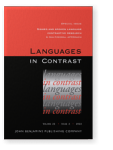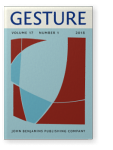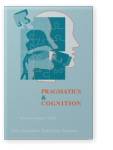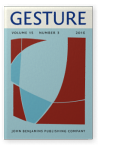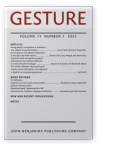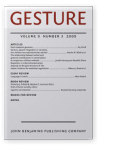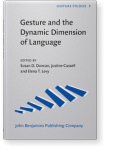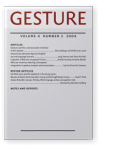Fey Parrill
List of John Benjamins publications for which Fey Parrill plays a role.
2022 The interface between grammar and bodily enactment in ASL and English Signed and spoken language contrastive research: A multimodal approach, Gabarró-López, Sílvia and Laurence Meurant (eds.), pp. 195–226 | Article
Users of signed and spoken languages regularly engage bodily enactment (commonly referred to as constructed action [CA] for signers and character viewpoint gestures [CVPT] for speakers) for the creation of meaning, but comparatively few studies have addressed how linguistic grammar interfaces… read more
2018 Seeing first person changes gesture but saying first person does not Gesture 17:1, pp. 158–175 | Article
Events with a motor action component (e.g., handling an object) tend to evoke gestures from the point of view of a character (character viewpoint, or CVPT) while events with a path component (moving through space) tend to evoke gestures from the point of view of an observer (observer viewpoint,… read more
2017 Gestures of the abstract: Do speakers use space consistently and contrastively when gesturing about abstract concepts? Pragmatics & Cognition 24:1, pp. 33–61 | Article
Speakers perform manual gestures in the physical space nearest them, called gesture space. We used a controlled elicitation task to explore whether speakers use gesture space in a consistent way (assign spaces to ideas and use those spaces for those ideas) and whether they use space in a… read more
2016 Do people gesture more when instructed to? Gesture 15:3, pp. 357–371 | Article
Does being instructed to gesture encourage those with low gesture rates to produce more gestures? If participants do gesture more when asked to, do they produce the same kinds of gestures? Does this vary as a function of the type of discourse being produced? We asked participants to take part in… read more
2011 The relation between the encoding of motion event information and viewpoint in English-accompanying gestures Gesture 11:1, pp. 61–80 | Article
Properties of motion events (e.g., path, manner) and point of view (e.g., character’s point of view, observer’s point of view) can both be encoded in co-speech gestures. How are these two dimensions of meaning associated? In an examination of English narrative data collected under controlled… read more
2009 Dual viewpoint gestures Gesture 9:3, pp. 271–289 | Article
This paper examines gestures that simultaneously express multiple physical perspectives, known as dual viewpoint gestures. These gestures were first discussed in McNeill’s 1992 book, Hand and mind. We examine a corpus of approximately fifteen hours of narrative data, and use these data to extend… read more
2008 Form, meaning, and convention: A comparison of a metaphoric gesture with an emblem Metaphor and Gesture, Cienki, Alan and Cornelia Müller (eds.), pp. 195–217 | Article
Speakers tend to produce very similar-looking gestures in very similar discourse contexts. This chapter probes the sources of such uniformity with reference to a particular gesture form. When producing this gesture form, a speaker’s hand moves towards her interlocutor with the palm facing up, as… read more
2007 7 Metagesture: An Analysis of Theoretical Discourse about Multimodal Language Gesture and the Dynamic Dimension of Language: Essays in honor of David McNeill, Duncan, Susan D., Justine Cassell and Elena T. Levy (eds.), pp. 83–89 | Chapter
2005 Festschrift Conference Honoring David McNeill, held at the University of Chicago, June 8th 2003 Gesture 4:2, pp. 251–255 | Miscellaneous
2005 What we mean by meaning: Conceptual integration in gesture analysis and transcription Gesture 4:2, pp. 197–219 | Article
Determining what a gesture “means” is an intuitive inferential process, which can profit from the application of a formalism which guides analysis. This paper uses a detailed exploration of a single example to illustrate the efficacy of the conceptual integration framework (Fauconnier & Turner,… read more
